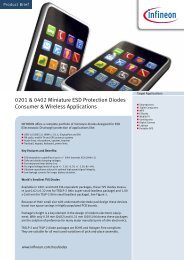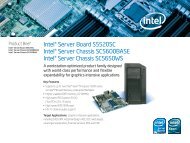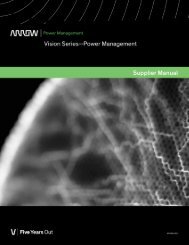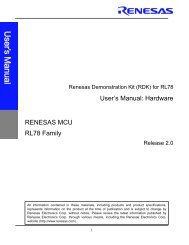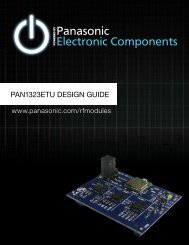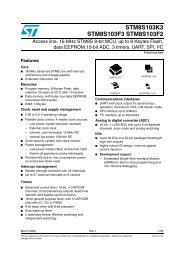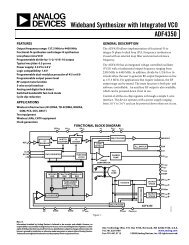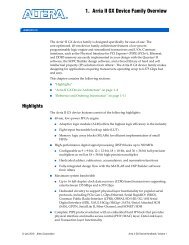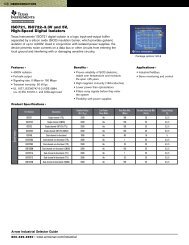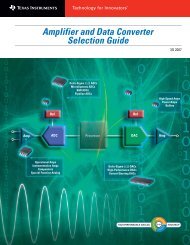Medical Applications Guide (Rev. B - Mouser Electronics
Medical Applications Guide (Rev. B - Mouser Electronics
Medical Applications Guide (Rev. B - Mouser Electronics
You also want an ePaper? Increase the reach of your titles
YUMPU automatically turns print PDFs into web optimized ePapers that Google loves.
48➔<strong>Medical</strong> ImagingUltrasound/Portable Ultrasoundperformance is defined by the magnitude of the input signal. The ratiobetween these two signals defines the dynamic range of the system.Many receive chains integrate the LNA with a variable gain amplifier.Low-pass filtering is typically used between the VCA and the ADC asan anti-aliasing filter and to limit the noise bandwidth. Depending onthe specific system two- to five-pole filter, linear phase topologiescan be found here. In selecting an op amp, the primary considerationsinclude signal swing, minimum and maximum input frequencies, harmonicdistortion and gain requirements. Analog-to-digital converters(ADCs) are typically 10- and 12-bit. SNR and power consumption arethe most important issues, followed by channel integration.Another trend in ADCs is the implementation of an LVDS interfacebetween the ADC and the beamformer. By serializing the data comingout of the ADC, the number of interface lines can be reduced from6144 to 1024 for a 512-channel system. This reduction translatesto smaller and lower-cost PC boards, an essential part of portableimaging systems.Among the functions the DSP can perform in the imaging systemare the Doppler processing, 2D, 3D and even 4D imaging as well asa host of post processing algorithms to increase functionality andimprove performance. The key requirements of the imaging systemare high performance and high bandwidth. The TMS320C6455BZTZDSP meets both these needs. The C6455 runs at 1GHz to handle theintensive processing needs of ultrasound and the SerialRapidIOperipheral provides 10Gb/s full duplex bandwidth.There are many different levels of performance and functionality inultrasound systems. Some solutions may have pieces that require ahigh dynamic range or that have functions that take far less cycles todo in floating point. Examples of these type of functions are spectralreduction and square root functions. The TMS320C6727 fits very wellfor these areas where floating point works best. When an ultrasoundsolution requires an operating system, the TMS320DM6446 mayfill the need. In addition to having a powerful TMS32CC64x+ coreand video accelerators to handle the imaging needs, the DM6446 alsohas an ARM9 core capable of handling the OS requirements.The signal assembly is accomplished with a digital beamformer.This is typically a custom-designed ASIC, but this function has beenimplemented in different forms of programmable logic. Within thebeamformer the digitized signal is scaled and time delayed to createthe focusing effect in the receive chain. The properly adjusted signalsare then summed together across all receive channels and passedto the imaging system. The imaging system can be developed as aseparate ASIC, can be a programmable processor such as a DSP, ormight be a full desktop computer.Transmit elements require the control of 100V to 200V of signal swing.This is almost always accomplished with the use of high-voltage FETs.Control of the FETs can take one of two forms: on-off (push-pull) orclass-AB linear control. The most popular is the push-pull approach,as it requires a much simpler and lower-cost interface to the FETs.The class-AB approach dramatically improves harmonic distortionbut requires more complex drivers and consumes more power.A wide variety of TI products have been chosen by system andequipment manufacturers for their ultrasound imaging applications,including op amps; single, dual and octal ADCs (all with fast-inputoverload recovery and excellent dynamic performance); digital signalprocessors; and the VCA8617, an integrated 8-channel, low-powerultrasound front-end IC. TI is also offering the ADS5270, an advanced8-channel, 12-bit data converter with serialized LVDS interface,specifically for the ultrasound market.TUS5000EVM Allows Rapid Prototypingfor Ultrasound <strong>Applications</strong>The TUS5000EVM was designed to interface four two-channelVCA2615 variable gain amplifiers with the 8-channel ADS5272serialized LVDS-output ADC. A high-performance clock synchronizerand jitter cleaner, the CDCM7005, provides the 65MHz clock to theADS5272 with a bypass option available. Designers can simply applytheir real world input circuitry, such as an ultrasound probe, to theevaluation module to quickly evaluate the performance of TI's analogreceive chain solution.With a combined power per channel of 277mW, the VCA2615 andADS5272 can be used for midrange and high-performance ultrasoundapplications.A deserializer such as TI's ADSDESER-50EVM, is necessary in orderto convert the serial LVDS outputs of the ADS5272 to parallel datafor a complete evaluation.Pricing and AvailabilityThe TUS5000EVM is available today from TI. The price of $299includes the evaluation module and User's <strong>Guide</strong>. The ADSDESER-50EVM is also available today from TI. The price of $399 includesthe evaluation module, datasheet and User's <strong>Guide</strong>.TransducerInputVCA2615VCA2615VCA2615VCA2615High-performance ultrasound signal chain.MSP430ADS5272CDCM70058 Eight-ChannelSerialized LVDSto Data Evaluation<strong>Medical</strong> <strong>Applications</strong> <strong>Guide</strong> Texas Instruments 2Q 2007



